
Traffic comprises pedestrians, vehicles, ridden or herded animals, trains, and other conveyances that use public ways (roads/sidewalks) for travel and transportation.

Traffic Message Channel (TMC) is a technology for delivering traffic and travel information to motor vehicle drivers. It is digitally coded using the ALERT C or TPEG protocol into Radio Data System (RDS) carried via conventional FM radio broadcasts. It can also be transmitted on Digital Audio Broadcasting or satellite radio. TMC allows silent delivery of dynamic information suitable for reproduction or display in the user's language without interrupting audio broadcast services. Both public and commercial services are operational in many countries. When data is integrated directly into a navigation system, traffic information can be used in the system's route calculation.

A green wave occurs when a series of traffic lights are coordinated to allow continuous traffic flow over several intersections in one main direction.
In transportation engineering, traffic flow is the study of interactions between travellers and infrastructure, with the aim of understanding and developing an optimal transport network with efficient movement of traffic and minimal traffic congestion problems.

The GEH Statistic is a formula used in traffic engineering, traffic forecasting, and traffic modelling to compare two sets of traffic volumes. The GEH formula gets its name from Geoffrey E. Havers, who invented it in the 1970s while working as a transport planner in London, England. Although its mathematical form is similar to a chi-squared test, is not a true statistical test. Rather, it is an empirical formula that has proven useful for a variety of traffic analysis purposes.
Microsimulation is the use of computerized analytical tools to perform analysis of activities such as highway traffic flowing through an intersection, financial transactions, or pathogens spreading disease through a population on the granularity level of individuals. Synonyms include microanalytic simulation and microscopic simulation. Microsimulation, with its emphasis on stochastic or rule-based structures, should not be confused with the similar complementary technique of multi-agent simulation, which focuses more on the behaviour of individuals.
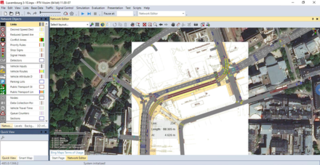
PTV Vissim is a microscopic multi-modal traffic flow simulation software package developed by PTV Planung Transport Verkehr AG in Karlsruhe, Germany. It was first developed in 1992. The name is derived from "Verkehr In Städten - SIMulationsmodell".
In traffic engineering, saturation describes the maximum traffic flow which can be handled by a junction. The saturation flow is the rate at which a continuous flow of vehicles can pass through a constant green signal, typically expressed in vehicles per hour or PCUs per hour.

The normal function of traffic lights requires more than sight control and coordination to ensure that traffic and pedestrians move as smoothly, and safely as possible. A variety of different control systems are used to accomplish this, ranging from simple clockwork mechanisms to sophisticated computerized control and coordination systems that self-adjust to minimize delay to people using the junction.
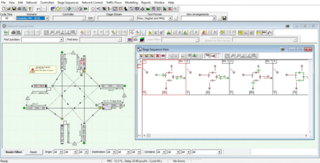
LinSig is software by JCT Consultancy which allows traffic engineers to model traffic signals and their effect on traffic capacities and queuing. As well as modelling the effects of traffic signals LinSig also optimises signal timings to reduce delay or increase capacity at a junction or group of interlinked junctions.
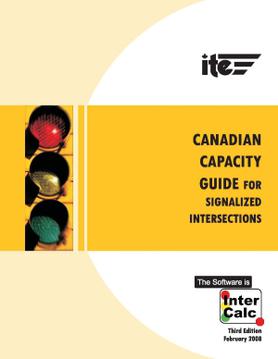
The Canadian Capacity Guide for Signalized Intersections (CCG) is a publication of the Canadian Institute of Transportation Engineers (CITE). It provides a methodology that allows Traffic Engineers to plan, design, and evaluate traffic signal controlled roadway intersections.

Traffic simulation or the simulation of transportation systems is the mathematical modeling of transportation systems through the application of computer software to better help plan, design, and operate transportation systems. Simulation of transportation systems started in the 1950s, and is an important area of discipline in traffic engineering and transportation planning today. Various national and local transportation agencies, academic institutions and consulting firms use simulation to aid in their management of transportation networks.
Paramics is traffic microsimulation software, originally developed by Quadstone Ltd. There is a related pedestrian microsimulation product called the Urban Analytics Framework.
Cell Transmission Model (CTM) is a popular numerical method proposed by Carlos Daganzo to solve the kinematic wave equation. Lebacque later showed that CTM is the first order discrete Godunov approximation.
TRANSYT-7F is a traffic simulation and signal timing optimization program. The primary application of TRANSYT-7F is signal timing design and optimization. TRANSYT-7F features genetic algorithm optimization of cycle length, phasing sequence, splits, and offsets. TRANSYT-7F combines a detailed optimization process with a detailed macroscopic simulation model.
TSIS-CORSIM is a microscopic traffic simulation software package for signal systems, highway systems, freeway systems, or combined signal, highway and freeway systems. CORSIM consists of an integrated set of two microscopic simulation models that represent the entire traffic environment. NETSIM represents traffic on urban streets. FRESIM represents traffic on highways and freeways. Microscopic simulation models the movements of individual vehicles, which include the influences of geometric conditions, control conditions, and driver behavior. TSIS is an integrated development environment that enables users to conduct traffic operations analysis. Built using a component architecture, TSIS allows the user to customize the set of included tools, define and manage traffic analysis projects, define traffic networks and create inputs for traffic simulation analysis, execute traffic simulation models, and interpret the results of those models.
Sidra Intersection is a software package used for intersection (junction), interchange and network capacity, level of service and performance analysis, and signalised intersection, interchange and network timing calculations by traffic design, operations and planning professionals.
Scalable Urban Traffic Control (SURTRAC) is an adaptive traffic control system developed by researchers at the Robotics Institute, Carnegie Mellon University. SURTAC dynamically optimizes the control of traffic signals to improve traffic flow for both urban grids and corridors; optimization goals include less waiting, reduced traffic congestion, shorter trips, and less pollution. The core control engine combines schedule-driven intersection control with decentralized coordination mechanisms. Since June 2012, a pilot implementation of the SURTRAC system has been deployed on nine intersections in the East Liberty neighborhood of Pittsburgh, Pennsylvania. SURTRAC reduced travel times by more than 25% on average, and wait times were reduced by an average of 40%. A second phase of the pilot program for the Bakery Square district has been running since October 2013. In 2015, Rapid Flow Technologies was formed to commercialize the SURTRAC technology. The lead inventor of this technology, Dr. Xiao-Feng Xie, states that he has no association with and does not provide technical support for this company.
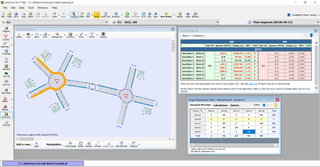
Junctions is a software package by Transport Research Laboratory. It incorporates the previously separate programs ARCADY, PICADY and OSCADY. The latest version, Junctions 10, was launched on 3 February 2021.
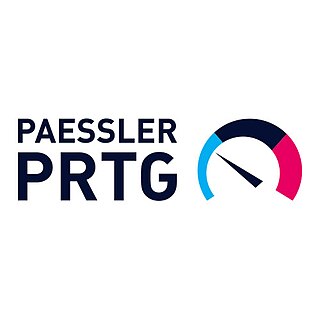
PRTG is a network monitoring software developed by Paessler GmbH. It monitors system conditions like bandwidth usage or uptime and collect statistics from miscellaneous hosts such as switches, routers, servers, and other devices and applications.











